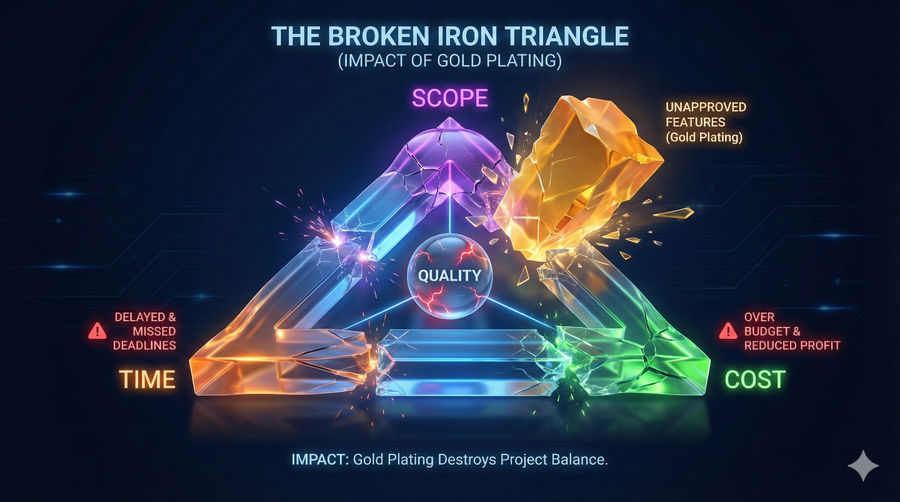Understanding Gold Plating in Project Management Risks
Here’s the thing about gold plating in project management: it’s like putting a diamond tiara on a potato. Sure, it’s shiny, but does it really add value?
In the world of the PMP (Project Management Professional), gold plating is a trap. It refers to the practice of adding unnecessary features or enhancements to a project that go beyond the agreed-upon scope.
While often born from good intentions, like wanting to wow clients or show off technical skills, gold plating rarely leads to gold stars. Instead, it leads to ballooning costs, missed deadlines, and unmanaged expectations. To rank successful projects, you must understand why "over-delivering" is actually a project management failure.
According to ActiveCollab, "Gold plating can have negative consequences, including increased costs, extended timelines, and decreased project efficiency."

What is Gold Plating in Project Management?
Gold plating occurs when a project team member or manager adds extra features, functionality, or services to the deliverables that were not requested by the client or defined in the project scope baseline. But as ScopeStack points out, this can lead to unrealistic client expectations and wasted resources.
The term implies covering a base metal with gold to make it look valuable, but underneath, the structure hasn't changed. In project management, it is considered a bad practice because it consumes resources (time and budget) without unauthorized approval.
The Psychology: Why Do Teams Do It?
If it’s bad for business, why is the gold plating process so common?
The Hero Syndrome: Team members want to prove their competence or "gift" the client something extra to secure future work.
Distraction: Sometimes, teams add flashy features to hide defects or shortcomings in the core requirements.
Perfectionism: A developer or engineer might feel the product "isn't good enough" yet, even if it meets the requirements.
Gold Plating vs. Scope Creep: What’s the Difference?
To pass the PMP exam or manage a real-world project, you must distinguish between gold plating and scope creep. They both ruin projects, but they originate from different sources.
Scope Creep is when the customer or stakeholder asks for small changes that eventually blow up the scope.
Gold Plating is when the team adds changes without being asked.

Comparison: Gold Plating vs. Scope Creep
Feature | Gold Plating | Scope Creep |
|---|---|---|
Origin | Internal (The Project Team) | External (The Client/Stakeholder) |
Cause | Desire to impress or hide defects | Unclear scope or uncontrolled requests |
Approval | Unapproved / Secretive | Unapproved / Informal |
Impact | Increases cost/risk unnecessarily | Increases cost/risk unnecessarily |
Common Examples of Gold Plating
To better identify this risk, here are scenarios explaining what gold plating looks like in practice:
1. The "Extra" Mobile App Feature
You are building a banking app. The scope requires a login and balance check. A developer decides, "It would be cool to add a Crypto-tracker widget," and builds it over the weekend.
The Risk: The client didn't ask for it. Now you have to test it, secure it, and maintain it. If it breaks, the client will blame you for a feature they never bought.
2. The Unnecessary Hardware Upgrade
In an IT infrastructure project, the manager orders higher-end servers than specified in the contract because they "might need the speed later."
The Risk: This eats into the profit margin of the project. The client may refuse to pay the difference because they only authorized the standard server cost.
3. Over-Reporting
A consultant delivers a 100-page market analysis when the contract asked for a 10-page summary.
The Risk: The client feels overwhelmed rather than impressed. The time spent writing the extra 90 pages is non-billable hours.
Identifying the Risks: What Impact Does Gold Plating Have on a Project?
Gold plating is not "value-added"; it is waste. Here is how it impacts the "Triple Constraint" (Time, Cost, Scope).

1. Increased Costs and Reduced Profit
Every hour spent on an unrequested feature is an hour you are paying for but cannot bill the client for. Gold plating eats directly into the project's profit margin. As monday.com puts it, "Gold plating typically results in diminished returns," because all those unnecessary enhancements eat up time and resources that could be better spent elsewhere.
2. Spiked Risk Factors
New features introduce new failure points. If you add code that wasn't in the plan, you might introduce bugs that crash the core system. Because these features weren't in the scope, they likely weren't subjected to standard risk analysis.
3. Setting Unrealistic Expectations
This is the most dangerous long-term impact. If you give a client "freebies" on Project A, they will expect them on Project B. You are training the client to expect more than they pay for, which devalues your work.
4. Rejection of Deliverables
Imagine painting a client's room blue, but you decide to add gold trim because it looks fancy. The client might hate gold trim. They are within their rights to reject the work and demand you remove it at your own expense.
Strategies to Prevent Gold Plating in Your Projects
As a project manager, it is your job to protect the scope. Here is how you deal with gold plating:
Establish a Strict Change Control Process
In PMP methodology, any change, whether from the client or the team, must go through Integrated Change Control. If a team member has a great idea, it shouldn't just be added. It must be proposed, analyzed for cost/time impact, and approved by the client.
Clear Scope Definition
Ensure the project scope statement is detailed. If the boundaries of the project are vague, team members will fill in the blanks with their own ideas.
Open Communication
Foster a culture where "value" is defined by meeting requirements, not exceeding them. Remind the team that the best way to impress a client is to deliver exactly what was promised, on time and on budget.
Frequently Asked Questions (FAQ)
What is gold plating in a project?
Gold plating in a project is the act of adding extra features, functionality, or higher-quality components to a deliverable that were not requested by the client or specified in the project scope.
What impact does gold plating have on a project?
Gold plating negatively impacts projects by increasing costs, delaying schedules, introducing new risks or bugs, and creating unrealistic expectations for future projects. It often reduces the overall profit margin.
What is gold plating in the context of project management?
In the context of project management (specifically PMP), gold plating is considered a failure of scope management. It implies that the project manager has lost control over the team's work and is allowing unauthorized changes to bypass the change control process.
Is gold plating good or bad in project management?
Gold plating is generally seen as a bad practice because it leads to a host of negative consequences—think project delays, budget overruns, and unrealistic client expectations. While the intention might be to exceed expectations, the reality often results in dissatisfaction. As noted in the monday.com blog, it’s crucial to stick to the original project scope.
What does the term gold plating mean?
The term originates from the idea of plating a less valuable metal (like copper) with gold to make it appear more valuable. In business, it means dressing up a project with "nice-to-have" features that do not add core value to the agreed-upon requirements.
What is the gold plating process?
The process usually begins when a technical team member identifies an opportunity to improve a product and implements it without consulting the project manager or client. It bypasses the formal "Change Control Board" and is often done in secret or as a surprise.
What are the advantages of gold plating?
Technically, there are no advantages to gold plating in formal project management. However, some argue that in rare cases, small additions can delight a customer (also known as "customer delight"). However, if these additions are not approved, the risks outweigh the benefits.
How do you deal with gold plating in your project?
You deal with gold plating by enforcing a strict scope baseline. Implementing a formal change management system ensures that no features are added without approval. Regular team check-ins and monitoring deliverables against the requirements traceability matrix will also prevent it.
Key Takeaways: Mastering Scope with Modall
If you take nothing else from this guide, remember that successful project management isn't about saying "yes" to every idea, it's about delivering exactly what brings value to your business.
Gold Plating is a Silent Budget Killer: It often comes disguised as "added value," but unapproved features drain resources, delay launches, and introduce unverified risks.
Scope Creep vs. Gold Plating: Know the difference. Scope creep comes from uncontrolled external requests; gold plating comes from internal perfectionism. Both require a strong "Change Control" process to manage.
The "Triple Constraint" is Real: You cannot arbitrarily add features without impacting time, cost, or quality. Respecting the scope baseline is the mark of a professional project manager.
Prevention is Cheaper than Correction: It is far more cost-effective to define a clear scope upfront than to remove unwanted code or patch bugs in unrequested features later.
Why Work With Modall?
At Modall, we don't just write code; we engineer value. As Toronto’s premier custom software development company, we understand that you need a partner who respects your budget and timeline. Here is how our approach protects your project:
Strict MVP Focus: Whether it's SaaS or a mobile app, we specialize in defining and delivering a Minimum Viable Product. We build exactly what you need to validate your market, without the expensive fluff.
100% In-House Toronto Team: Miscommunication is the leading cause of scope issues. We don’t outsource. By keeping all development in-house in Toronto, we ensure that the developers building your product fully understand your vision, eliminating the "lost in translation" errors that lead to gold plating.
Transparent Scope Management: We believe in "No Surprise" billing. Our transparent communication channels ensure that if a new feature is needed, it goes through a proper review process where you make the final call on the budget impact.
Ready to build software that hits the mark without breaking the bank? Stop paying for features you didn't ask for. Partner with a team that values your ROI as much as you do.
Contact Modall Today for a Free Project Estimate

